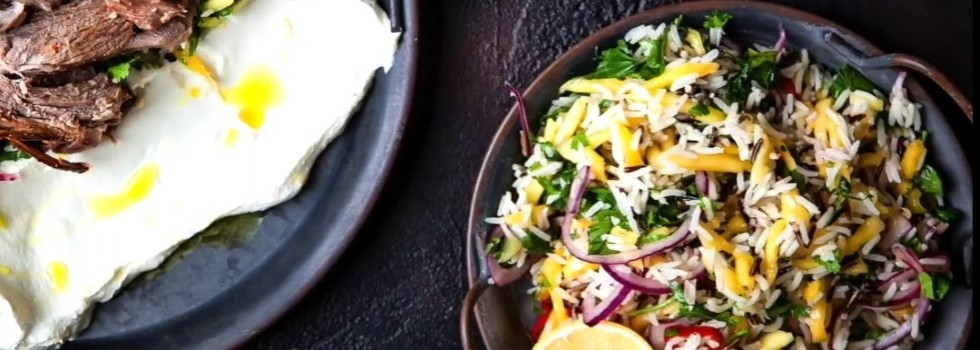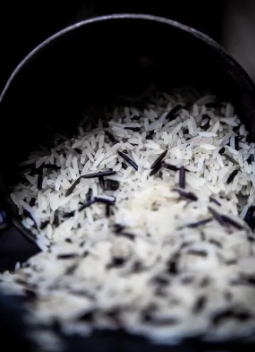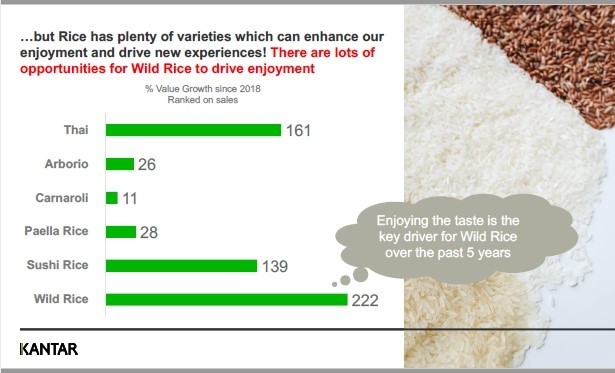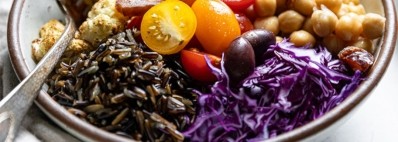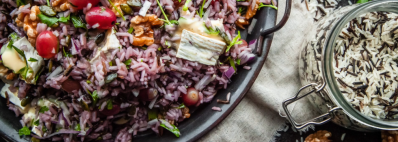Promotional Features
How wild rice can play a key role in modern consumer diets
Consumption habits have changed since the Covid-19 pandemic. How consumers eat, drink and shop has altered, but some familiar patterns have been retained.
While FMCG like-for-like inflation has hit a record high, spend lags behind. Buying exactly the same items today as in September 2019 would cost the average shopper £49 more every four weeks, but shoppers are actually spending just £37 more according to research for USA Wild Rice by Kantar1.
Meanwhile, heightened costs out-of-home mean that consumers are once again staying in more and entertaining more in the home environment. In fact, in-home consumption occasions are 7% bigger (at +1.1bn) compared to out-of-home occasions that are 10% smaller (-627m)2.
Hybrid working has also created the opportunity for more meal occasions at home, with consumers focused on both convenience and health & wellbeing post-pandemic.
Back to the store cupboard
When it comes to cooking at home, store cupboard staples such as rice have become increasingly important. According to Kantar’s research, 86% of GB households buy chilled dry or pouch rice each year, with 1.74bn meals containing rice eaten annually in the home3. In fact, the percentage of main meals containing rice has grown from 5% in 2018 to 5.3% in 20224.
Convenience remains top of the purchasing motivations for consumers, with ready-to-cook rice dominating value sales in the market, but dry rice dominating volume sales, reveals Kantar. With consumers also keen to recreate restaurant-style meals at home and explore different cuisines, rice has taken a more prominent role as, for example, Indian, Italian and Oriental foods gain traction in at-home meal occasions5.
In the meantime, with wellbeing concerns to the fore, consumers are seeking out healthy options for lunch and dinner. With both flexatarianism and veganism on the rise, and the annual post-Christmas Veganuary now in full swing in the UK, shoppers are looking for meat-free alternatives, but are still trying to achieve a balanced diet with sufficient protein intake. Rice - and in particular wild rice - scores high on protein, but also offers consumers a convenient staple and versatile ingredient to enhance and accompany a broad variety of dishes.
However, while Kantar’s research has found that rice scores highly as a healthier carb, with 30% of servings for health, just behind potatoes at 33%, it still has a way to go in terms of persuading consumers of its overall enjoyment, lagging behind options such as pasta, potatoes and chips6. As such, there is a clear opportunity for rice to enhance its position in terms of enjoyment and drive new experiences in the market.
This, says Piers Stevens, head of ingredients at S&B Herba, one of the leading suppliers of US wild rice to the UK, is where this increasingly popular ingredient comes in. Wild rice is a unique ancient grain, originating from North America with a high visual appeal and nutty taste. It is mostly sold in mixes with regular rice, and is also a popular ingredient in the food manufacturing and processing sector to create appealing taste experience as well as increase nutritional value. Taste has become a key driver for wild rice over the past five years, with value growth up 222% since 2018, ranked on sales7, reveals Kantar. And, in terms of ready meals, 45% of British households buy a ready meal with rice each year, amounting to a value of £395m8.
So, for food manufacturers wishing to offer both healthy and convenient options to a UK audience, wild rice is a key player in the market, with opportunities to attract consumers on a number of counts. Wild rice can form a core part of UK meals in terms of cuisines, formats and innovation, but is also a recession-resistant and tasty ingredient that is filling, healthy and works with all types of dishes, notes Stevens.
US wild rice
As a wholegrain carb, suitable for gluten-free diets and low in calories, as well as being high in dietary fibre, wild rice offers consumers a healthier option with sustainable provenance. Wild rice is a wholegrain, and when cooked, has around 30% fewer calories than brown rice (101kcal per 100g cooked vs 123 kcal), but offers around 40% more protein (3.99g vs 2.74g per 100g cooked)9, so plays to those consumers seeking to enhance their protein intake and keen to pursue a more meat-free diet, reveals Stevens. Suitable for gluten-free diets, it is also low in calories, and high in dietary fibre and essential nutrients such as thiamin, lysine, riboflavin, Vitamin B and iron, thus helping to enhance the diets of those seeking ingredients that offer health & wellness benefits.
Beth Nelson, president of the Minnesota Cultivated Wild Rice Council adds: “Wild rice is an 'all-purpose' ingredient and its versatility shines through in all types of recipes. It has great taste and a distinctive flavour. This unique valued-added ingredient, is a great high-quality plant-based protein, rich in antioxidants and gluten free.
“It is also a good meat extender and is good for vegan or flexitarian diets."
Although the biggest US rice categories are long grain and easy cook long grain, wild rice is increasingly popular in the UK market and is broadening its notoriety and appeal every year, she explains.
“US wild rice production is done in a very sustainable manner through water conservation, soil management and sustainable farming practices," adds Nelson. Emanating from two major growing areas in the US – Minnesota and California – US wild rice is cultivated in still-water paddy fields, with no known significant damage to air, water, land, soil or forests. As such its provenance, sustainability and clean-label attributes are evident.
S&B Herba continues to grow awareness and sales of the category in the UK, sparking inspiration with recipe ideas to make wild rice more of a cupboard staple among consumers and an ingredients solution for food manufacturers than ever before.
To discover more about wild rice and its use in manufacturing, contact S&B Herba here or USA Wild Rice here.
To find out more about wild rice and some recipe suggestions involving its use, click on the video below:
Source
1 Kantar take-home FMCG PO9 2022, 4 w/e 04.09.22
2 Kantar Usage, Rolling in-home occasions, 12w/e 07.08.22 vs pre-pandemic average 2018/2019
3-8 Kantar 2022 research for USA Wild Rice
9 FoodData Central (usda.gov) and FoodData Central (usda.gov)
